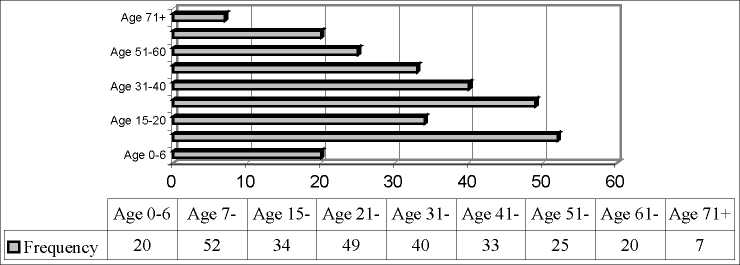RESULTS AND DISCUSSION
Since the main aim of the study is to identify the deprivation level of Tuzcu District, the results of the
field survey are evaluated in the titles of major population characteristics and material-social deprivation
measurement indicators. Some of the variables or indicators would not be directly related to the deprivation
measurement of the area, however it would provide essential information about the inhabitants and their
general social profile.
Demographic characteristics
The population characteristics of the area are examined for the whole research population that consist of
280 people of 65 households. Firstly, the place of birth is examined for the all-household members whereas
hometown information is examined for the whole households. Therefore, the origins of families and origins
of the individuals can be observed separately. Considering that the hometown distribution of the household,
it is observed that 33.8 % of the families are from izmir, 32.3 % are from Mardin, and the rest of them are
from the other cities as shown in the table 7. As mentioned before, the district lost population until 1970s.
During this period, house prices also decreased and the district became an accessible place for low-income
families. After this population exchange, the population profile of the district changed. At the begging of the
1970s, the population of the district increased by the migration from cities out of izmir (especially Mardin)
widely. On the other hand, the native families of izmir who can afford houses only in this region had moved
to the area. Therefore, the population of the district consists of two main groups. The first group is migrating
population from particularly Mardin, and the second group from izmir. There is a common feature between
these two groups, that is, the poverty.
Table 7: The Distribution of The Research Population by Hometown and Place of Birth
|
Hometown |
Frequency |
Rate (%) |
Place of |
Frequency |
Rate (%) | |
|
izmir_________ |
__________22 |
___________33.8 |
Izmir_________ |
__________129 |
__________46.1 | |
|
Mardin______ |
____________21 |
___________32.3 |
Mardin______ |
___________83 |
__________29.6 | |
|
Bitlis___________ |
______________5 |
____________7.7 |
Bitlis___________ |
___________17 |
_____________6.1 | |
|
Erzurum_____ |
_______________3 |
____________4.6 |
Erzurum_____ |
_____________9 |
_____________3.2 | |
|
Aydin_______ |
___________2 |
______________3.1 |
Batman______ |
_____________6 |
_____________2.1 | |
|
Batman_____ |
____________2 |
_____________3.1 |
Iskenderun |
______________5 |
_____________1.8 | |
|
Others_______ |
____________10 |
___________15.4 |
Urfa_________ |
______________5 |
_____________1.8 | |
|
Adana______ |
____________4 |
_____________1.4 | ||||
|
Denizli_______ |
___________4 |
_____________1.4 | ||||
|
Others_______ |
____________15 |
_____________5.4 | ||||
|
Total_________ |
___________65 |
__________100 |
Total_________ |
_________280 |
__________100 |
On the other hand, the distribution of the birthplace shows different ratios. While the ratio of the
population born in Mardin is 29, 6%, the ratio of the population born in izmir is 46, 1%. The main reason of
this situation can be explained by stabilization of the population. In other words, families who have settled
this area at 1970s have stated there instead of move out in a short term. So, their children were born here and
this ratio difference occurs due to this factor.
The age distribution of the research population is similar to the general age distribution of Turkey and
izmir. The 7.2% of the research population is within the range of age 0-6; 18.6% is within the range of age 7-
14; 64.6% within the range of age 15-60; and finally 9, 6% within the range of age 60 and above. As shown
in the following figure, most of the population belongs to the working and young age groups.
Figur 1: The Age Distribution of the Research Population

13
More intriguing information
1. Opciones de política económica en el Perú 2011-20152. EXECUTIVE SUMMARIES
3. FASTER TRAINING IN NONLINEAR ICA USING MISEP
4. I nnovative Surgical Technique in the Management of Vallecular Cyst
5. Towards a framework for critical citizenship education
6. A methodological approach in order to support decision-makers when defining Mobility and Transportation Politics
7. Mergers and the changing landscape of commercial banking (Part II)
8. Protocol for Past BP: a randomised controlled trial of different blood pressure targets for people with a history of stroke of transient ischaemic attack (TIA) in primary care
9. Macro-regional evaluation of the Structural Funds using the HERMIN modelling framework
10. ALTERNATIVE TRADE POLICIES